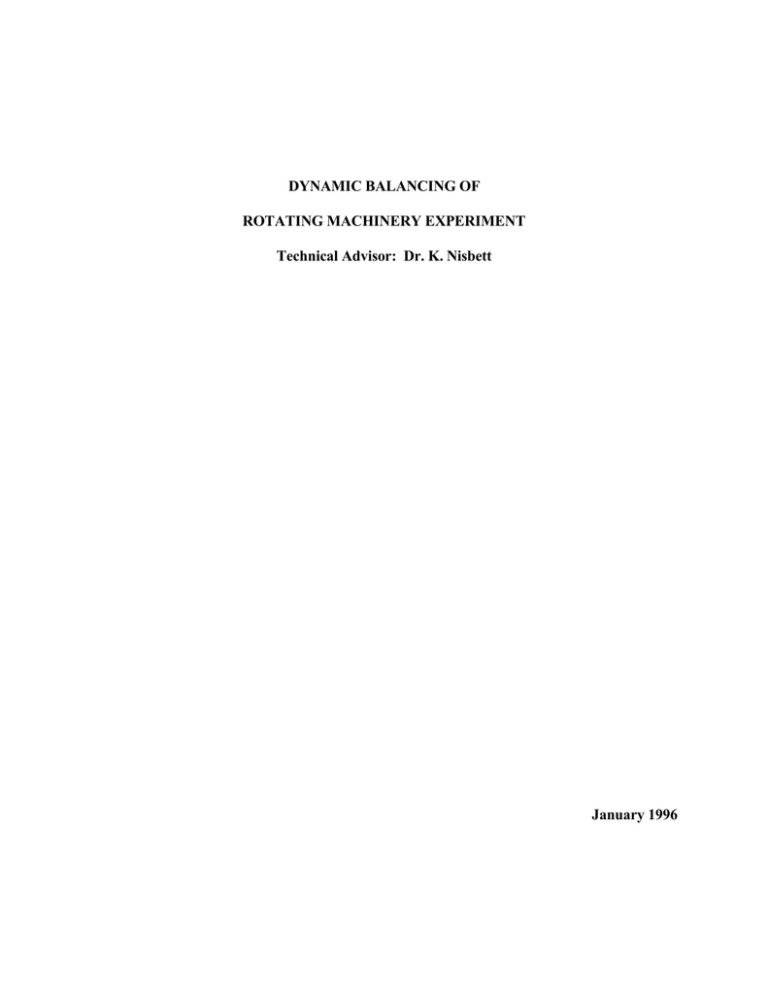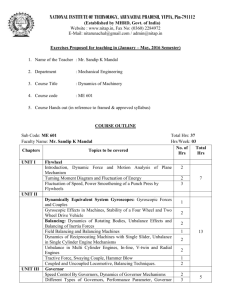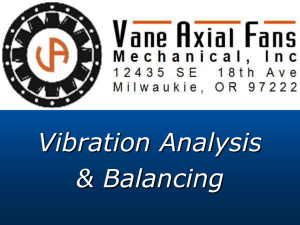DYNAMIC BALANCING OF ROTATING MACHINERY EXPERIMENT
advertisement

DYNAMIC BALANCING OF ROTATING MACHINERY EXPERIMENT Technical Advisor: Dr. K. Nisbett January 1996 6.1 GENERAL OBJECTIVES 1) To gain insight into the causes of undesirable vibration of rotors and to understand static and dynamic unbalance conditions of rotors. 2) To learn a simple, practical method of dynamic balancing that can be used in the field and appreciate its advantages and limitations. 6.2 INTRODUCTION Production tolerances used in the manufacture of rotors are adjusted as closely as possible without running up the cost of manufacturing prohibitively. In general, it is more economical to produce parts, which are not quite true, and then to subject them to a balancing procedure than to produce such perfect parts that no correction is needed. Typical examples of such machinery are crankshafts, electric armatures, turbo-machinery, printing rollers, centrifuges, flywheels, and gear wheels. Some common causes of irregularity during production are machining error, cumulative assembly tolerances, distortions due to heat treatment, blow holes or inclusions in castings, and material non-homogeneity. Because of these irregularities the actual axis of rotation does not coincide with one of the principal axes of inertia of the body, and variable disturbing forces are produced which result in vibrations. In order to remove these vibrations and establish proper operation, balancing becomes necessary. The forces generated due to an unbalance are proportional to the rotating speed of the rotor squared. Therefore, the balancing of high-speed equipment is especially important. Frequently, a machine already in operation will need re-balancing or a new machine when assembled at its permanent location will need balancing. In some cases, the cost of disassembly, shipping to a balancing machine, and delay, are prohibitive and the machine must be rebalanced in the field in its bearings. The system of balancing discussed in this experiment was developed to satisfy the need to perform field balancing of equipment easily and accurately. Although there are many possible causes of vibration in rotating equipment, this technique will deal only with that component of vibration, which occurs at running speed (frequency), and is caused by a mass unbalance in the rotor. Note: This component is the only component of vibration, which can be eliminated by the addition or removal of weight from the rotor. The condition of unbalance of a rotating body may be classified as static or dynamic unbalance. In the case of static unbalance, the unbalance appears in a single axial plane. In the case of dynamic unbalance, the unbalance can be in different axial planes. As a result, while in rotation, the two unbalanced forces form a couple, which rocks the axis of rotation and causes undesirable vibration of the rotor, mounted in its bearings. Let us now consider a single rigid rotating mass mounted in two supporting bearings and assume that the axis of rotation is horizontal. It can be shown that for the correct balance of such a rotor, two weights placed in different radial planes of the rotor are necessary and sufficient to balance the rotor. The vibratory motion of either bearing may be represented by three components, the horizontal and vertical radial components and the axial component. The purpose of balancing at running speed of the rotor is to reduce the greatest of these three components to a practical minimum. The other two components will be reduced to negligible amounts from their original magnitudes by this technique. Assume in this example that the radial component is the greatest. 53 Therefore, only this component will be measured and analyzed in this technique. It follows that if the vertical components of vibration of two points, one chosen on each bearing, are reduced to zero (or near zero) the purpose of balancing has been accomplished and no vibration will be transmitted to the support structure. There are four variables to be dealt with when balancing any rigid rotor. They are the amount and position of the two correction weights required to balance the rotor. Each correction weight is located in one of the arbitrary chosen radial reference planes on the rotor. These reference planes are usually placed near the support bearings. In general, the farther apart the radial reference planes are located, the smaller the required correction weight. This technique deals with these four variables simultaneously as the amount and position of the correction weight in the other reference plane. The data necessary to determine the magnitudes and position (angle) of the two correction weights are obtained by test runs, all at the same speed by measuring the vibration amplitude and phase angle at each bearing. Some commercial equipment allows measurement of the vibration amplitude and phase relative to a geometric trigger reference point on the rotor. Lacking the instrumentation to measure the phase angle, this technique will obtain data to allow calculation of the phase angle. An important assumption made by this technique is that the system follows linear relationships i.e., the vibration amplitude is proportional to the force producing the vibration. This assumption is reasonably valid. Most simple rotors/systems can be balanced by applying this technique iteratively. 6.3 EXPERIMENTAL SETUP The apparatus provided to you is shown in figure 6.1. The long, rigid rotor is supported in its bearings and is driven by a DC motor whose speed can be controlled. Note that the cradle on which these are mounted has been isolated from the supporting structure. Vibration amplitudes (not the phase angles) at bearings A and B are measured by accelerometers attached to them. The signal from the accelerometers is integrated and converted to an electrical signal, which is then displayed on the spectrum analyzer. Motor speed is also measured using the spectrum analyzer. 6.4 PROCEDURE Bearing in mind that our experimental apparatus measures only vibration amplitudes, we will measure values at both bearings with the trial mass at 0°, 90°, 180° and 270°, to determine the phase angle of vibration at both bearings. The procedure to acquire the required data and balance the rotor is as follows: 1) Vary the motor speed, recording the unbalance at each speed. 2) Select and record a motor speed, which will be held constant throughout the experiment. Make a note of the fact that this is the speed to which our final results (correct balancing weights) will apply. Results that you get using a lower speed can be later verified using higher speeds. 54 3) With only the original mass unbalances of the rotor, record vibration amplitudes at both bearings. Sketch the spectrum analyzer screen showing the original unbalance. 4) Arbitrarily choose a trial mass, mtrial and mount it on plane A of the rotor at an angle of 0°. Record readings at both bearings. Repeat this step with the trial mass at 90°, 180°, and 270°. 5) Repeat step 3 with the difference that the trial mass is now mounted on plane B of the rotor. 6) Mount the trial mass at 45° on plane A of the rotor and record reading at both bearings. This measurement is not needed for balancing the rotor, but will be used later as a check on calculations. 7) Using the equations described in section 6.5 (calculations) determine the 2 masses required at both planes A&B of the rotor to dynamically balance the rotor. These calculations will be performed manually, by you first, then check by running the computer code DYBAL. 8) Run the rotor with the correction masses added. Record the vibration amplitudes at both bearings. Sketch the spectrum analyzer screen. 55 Figure 6.1 Schematic of Dynamic Balancing Experimental Setup. 56 DATA SHEET Motor speed = _____________ RPM (= _______________Hz) Vibration Amplitudes due to original unbalance: Plane A: A = __________ Plane B: B = __________ Trial mass mtrial = __________ grams. Vibration Amplitudes with trial mass on Plane A. Trial Mass Position 0° Bearing A 90° A1 = ________ 180° A1 270° A1 Bearing B 0 B1 = _________ 90 B1 = ________ A1 = ________ 0 90 180 = _______ B1 180 = _______ 270 = _______ B1 270 = _______ Vibration Amplitudes with trial mass on Plane B. Trial Mass Position 0° Bearing A A2 = ________ 90° A2 = ________ 180° A2 270° A2 Bearing B 0 B2 = _________ 0 90 B2 = ________ 90 180 = _______ B2 180 = _______ 270 = _______ B2 270 = _______ Vibration Amplitudes with trial mass on Plane A Trial Mass Position 45° 45 A1 = _______ 45 B1 = _______ Vibration Amplitudes with corrected masses added Plane A: A = __________ Plane B: B = __________ 57 6.5 CALCULATIONS Let, A = vibration amplitude at Bearing A due to original unbalance of rotor. ΨA = vibration phase angle at Bearing A due to original unbalance of rotor. ∆A1 = additional vibration amplitude at Bearing A due to the trial mass mounted at any angle on plane A. (see figure below) A190 ∆A1 ∆A1 A1180 ∆A1 A10 A ∆A1 ΨA A1270 Figure 6.2 From these quantities we can derive. NOTE: You should prove this to yourself before you run the experiment. ΨA ∆A1 = = Tan −1[ ( A190 ) 2 − (∆A1 ) 2 − A2 ] ( A10 ) 2 − (∆A1 ) 2 − A2 ( A10 ) 2 + ( A1180 ) 2 − 2 A 2 = 2 ( A190 ) 2 + ( A1270 ) 2 − 2 A 2 2 (1) (2) Let, ∆A1 = additional vibration amplitude at Bearing A due to trial mass mounted at any angle on plane B. Then ∆A2 = ( A20 ) 2 + ( A2180 ) 2 − 2 A2 ( A290 ) 2 + ( A2270 ) 2 − 2 A2 = 2 2 58 (3) Defining B , ψ B , ∆B1 , and ∆B2 similar to the quantities above (except that they are measured at Bearing B), we can show that, B 90 2 − (∆B )2 − B 2 −1 1 ψ B = Tan 1 2 (4) B 0 − (∆B )2 − B 2 1 1 ( ) ( ) ∆B1 = (B ) + (B ) − 2B 2 ∆B2 = (B ) + (B ) − 2B 2 0 2 1 180 2 1 2 0 2 2 180 2 2 2 = (B ) + (B ) − 2B 2 = (B ) + (B ) − 2B 2 90 2 1 270 2 1 2 90 2 2 270 2 2 2 (5) (6) The purpose of calculating these ∆A and ∆B values is ultimately to determine the masses and their locations on planes A and B that will eliminate the vibration at both bearings. Let these correction masses be identified as M A and M B for planes A and B respectively. In this experiment there are only a limited number of locations where M A and M B can be attached. This problem is easily solved by calculating an x and y component of both M A and M B . Define vectors R A and RB as correction factors to be applied to the trial masses on planes A and B. The following equations express the relationships between the trial masses and the final correction masses. M A = R A M trial (7) M B = RB M trial (8) M Ax = R Ax M trial (9) M Ay = R Ay M trial (10) M Bx = RBx M trial (11) M By = RBy M trial (12) or in component form Recall that the vibration at bearing A was affected by the trial mass attached to plane A , ∆A1 , as well as by the trial mass attached to plane B, ∆A2 . It is desired to determine correction factors R A and RB which, when applied to the trial masses on planes A and B respectively, will cause the total change in vibration at bearing A to offset the original unbalance at bearing A. This can be expressed as: R A ∆A1 + R B ∆A2 = − A 59 (13) It is also necessary for the same correction factors to simultaneously balance bearing B. Thus, R A ∆B1 + R B ∆B2 = − B (14) Equations (13) and (14) state mathematically that the proper location of M A and M B on planes A and B will produce vectors equal to, but opposite in direction to the existing vibration (A and B ) thus eliminating the vibration. Resolving equations (13) and (14) into their x component equations gives: and R Ax ∆A1 + RBx ∆A2 = − A cosψ A (15) R Ax ∆B1 + RBx ∆B2 = − B cosψ B (16) Equations (15) and (16) can be readily solved for R Ax and RBx since all of the other quantities are known: R Ax = B(∆A2 )cosψ B − A(∆B2 )cosψ A (∆A1 )(∆B2 ) − (∆A2 )(∆B1 ) (17) − A cosψ A − R Ax ∆A1 ∆A2 (18) RBx = Similarly, Eqns. (13) and (14) can be resolved into their corresponding y component equations: and R Ay ∆A1 + RBy ∆A2 = − A sin ψ A (19) R Ay ∆B1 + RBy ∆B2 = − B sin ψ B (20) Again, equations (19) and (20) can be solved for since all other quantities are known: R Ay = and B(∆A2 )sin ψ B − A(∆B2 )sin ψ A (∆A1 )(∆B2 ) − (∆A2 )(∆B1 ) RBy = − A sin ψ A − R Ay ∆A1 ∆A2 (21) (22) The 4 individual required masses can now be determined from Eqns. (9), (10), (11) and (12). To place these masses at the correct locations, keep the following in mind: x component placed at 0° position if positive, placed at 180° position if negative y component placed at 90° position if positive, placed at 270° position if negative. 60 6.6 RESULTS OF INTEREST (1) Determine the percent reduction at each bearing. How can these results be improved further? (2) Using your calculated values, verify Equations (13) and (14) graphically. (3) Neatly sketch the original spectrum analyzer screen showing the original unbalance and the screen after the correction mass has been added. Explain all important features. (4) Plot vibration amplitudes of the unbalance rotor versus the motor speed. Explain this behavior. (5) Construct a scaled figure similar to Fig. 6.2 using the following procedure: (a) Draw vector using your measured magnitude and calculated direction. (b) From the tip of A, draw vertical and horizontal construction lines. (c) Draw vectors A1 , A1 , A1 , and A1 , using your measured magnitudes. The directions should be determined by placing the tips of the vectors on the horizontal or vertical construction lanes. (d) Measure from your figure the four distances corresponding to ∆A1 in Figure to your calculated ∆A1 . (e) Using the calculated values of ∆A1 and ∆B1 , draw vector diagrams to predict the vibration at bearings A and B due to the trial mass mounted at 45° on plane A. (You may use the above vector diagram for bearing A). Compare these values to the vibration amplitudes actually obtained when this trial mass is mounted. 0 90 180 270 6.7 REFERENCES 1. Shigley, Joseph E. and Vicker, John J., Jr., "Theory of Machines and Mechanisms", McGraw Hill inc., 1980. (pp 478-500 on Balancing) 2. Thearle, E. L. and Scheuectady, N. Y., "Dynamic Balancing of Rotating Machinery in the Field", ASME Transactions, Paper AMP 56-19, Vol. 56, 1934, pp 745-753. 3. Marks' Standard Handbook of Mechanical Engineers, edited by Baumeister, T., et. al, McGraw Hill Book Company, eighth edition, 1988, pp 3-17 to 3-18, 5-70 to 5-72, 5-75 to 5-76. 61



